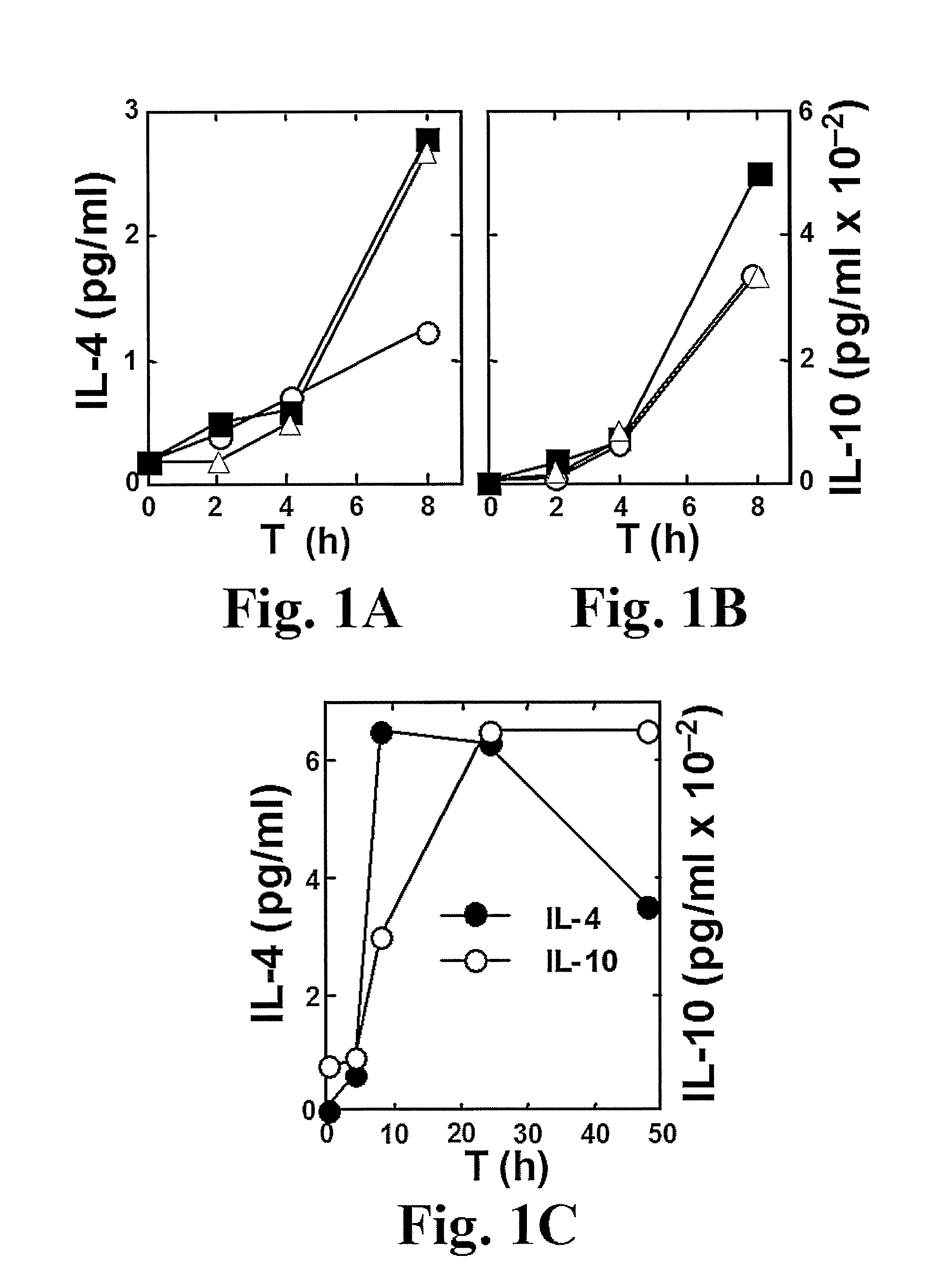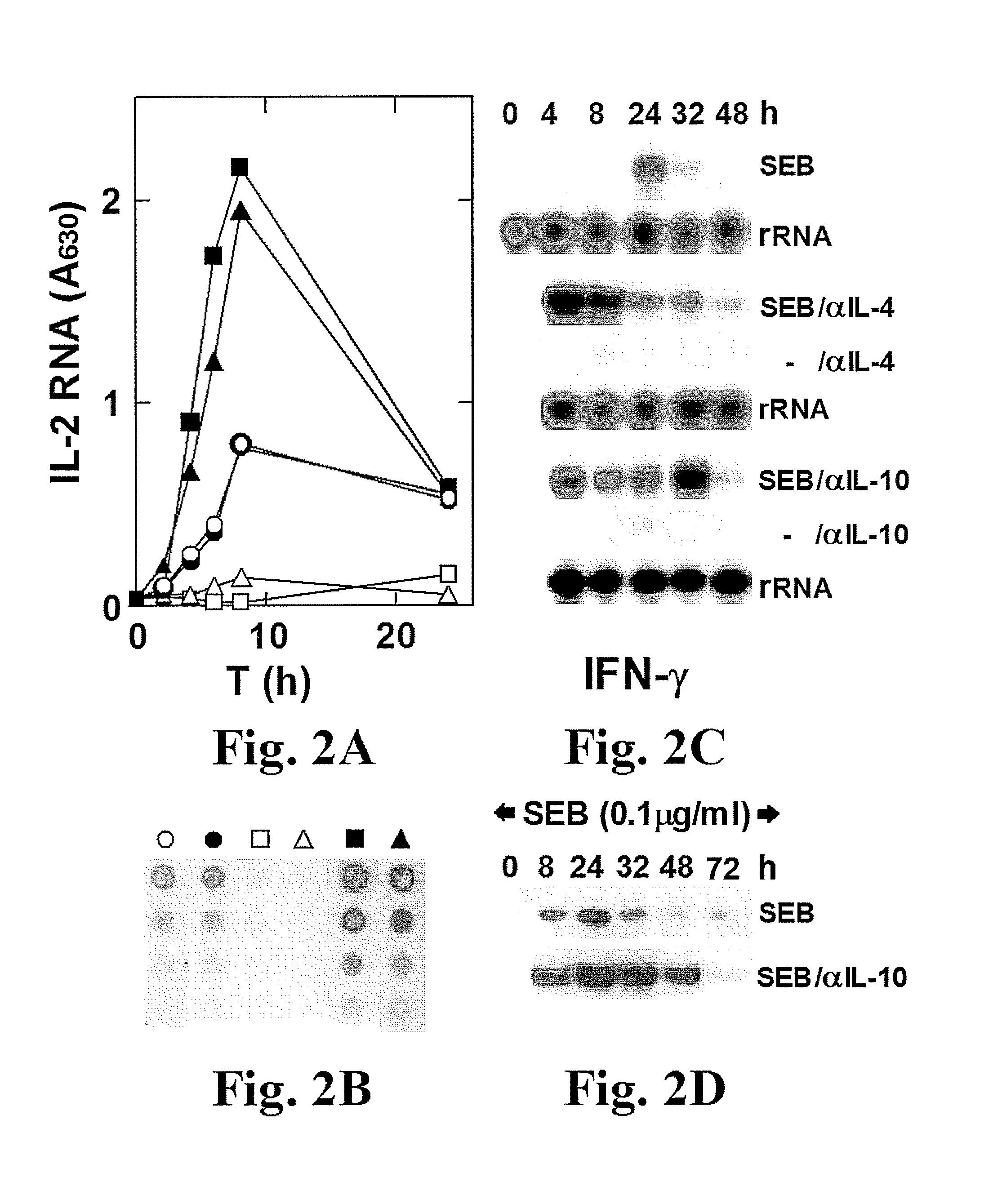Broad-spectrum in-vivo effective superantigen toxin antagonists based on the interaction between cd28 and the superantigen and uses thereof
a superantigen and superantigen technology, applied in the direction of peptide/protein ingredients, peptide sources, drug compositions, etc., can solve the problems of enhancing the vulnerability of conventional military means, affecting the effectiveness of fighting forces, and revealing considerable overlap in costimulatory functions
- Summary
- Abstract
- Description
- Claims
- Application Information
AI Technical Summary
Benefits of technology
Problems solved by technology
Method used
Image
Examples
example 1
A Superantigen, Exemplified by SEB, Induces the Early and Concomitant Expression of Th1 Cytokines, IL-2 and IFN-γ, and of Th2 Cytokines, IL-4 and IL-10
SEB Induces the Early Expression of Th2 Cytokines IL-4 and IL-10
[0463]Superantigens are thought to exert their toxic effects by overstimulating the Th1 response, involving the expression of IL-2, IFN-γ and TNF-β. It is also commonly believed that the Th2 response, which involves the expression of immunosuppressive cytokines, in particular IL-10, is a later event that acts to shut off the earlier Th1 response. In lymph nodes [Litton et al., J. Immunol. Methods 175:47-58, (1994)] or freshly isolated CD4 cells [Cardell et al., Eur. J. Immunol. 23:523-529, (1993); Nagelkerken et al., Eur. J. Immunol. 23:2306-2310, (1993)] from SEB-treated mice, there was rapid induction of mRNA for IL-2 and IFN-γ but not for IL-4 and IL-10. In murine CD4 cells, significant induction of IL-10 by SEB was seen in the presence of IL-2 and IL-4 but not in thei...
example 2
Specific Involvement / Requirement of B7-2 in Superantigen Activation of Th1 Cells
Anti-B7-2 Blocks the Th1 Response to SEB Yet Fails to Block the Th2 Response to SEB Whereas Anti-B7-1 Fails to Block Th1 or Th2 Responses
[0475]The inventors have now found that mAbs against B7-2 block the induction of IL-2 and IFN-γ mRNA by SEB in human PBMC, whereas mAbs against B7-1 have no such effect (FIG. 6A for IL-2 and 6B for IFN-γ). By contrast, the concomitant induction of IL10 and IL4 was resistant to either mAb (FIGS. 6C and 6D, respectively). These results were reproducible and show that as for conventional antigens [reviewed by Carreno, B. M. and Collins, M. Annu. Rev. Immunol. 20:29-53 (2002); Collins, A. V. et al., Immunity 17:201-210 (2002)], induction of a Th1 response by SEB relies selectively on signaling via B7-2 / CD28.
[0476]This correlation between the lack of inhibition of IL-10 production by antagonist peptide on one hand and by anti-B7-2 on the other, in conditions where the Th1 re...
example 3
Superantigen-Mediated Activation of Th1 Cells, but not Activation of Th2 Cells, is Dependent Upon the CD28 Receptor which Serves as the Antagonist Target
Soluble CD28 Receptor Blocks the SEB-Mediated Induction of Th1 Cytokine Gene Expression Yet Fails to Block the Th2 Response to SEB
[0479]The following set of observations provides strong evidence that the CD28 receptor is the antagonist target. Human PBMC were induced by various protocols. Expression of IL-2 and IFN-γ mRNA was used as readout for a Th1 response and expression of IL-10 protein as readout for a Th2 response.
[0480]Recombinant soluble CD28 receptor (sCD28) is a chimeric molecule composed of the extracellular 1 to 152-amino acid domain of the human CD28 molecule fused to the C-terminal, histidine-6-tagged Fc region of human IgG (catalogue no. 342-CD of R&D Systems, Inc., Minneapolis, Minn., USA). Induction of IL-2 mRNA by SEB was inhibited 3.5-fold by sCD28 which by itself did not induce this gene (FIGS. 7A and B). By con...
PUM
 Login to View More
Login to View More Abstract
Description
Claims
Application Information
 Login to View More
Login to View More - R&D
- Intellectual Property
- Life Sciences
- Materials
- Tech Scout
- Unparalleled Data Quality
- Higher Quality Content
- 60% Fewer Hallucinations
Browse by: Latest US Patents, China's latest patents, Technical Efficacy Thesaurus, Application Domain, Technology Topic, Popular Technical Reports.
© 2025 PatSnap. All rights reserved.Legal|Privacy policy|Modern Slavery Act Transparency Statement|Sitemap|About US| Contact US: help@patsnap.com



